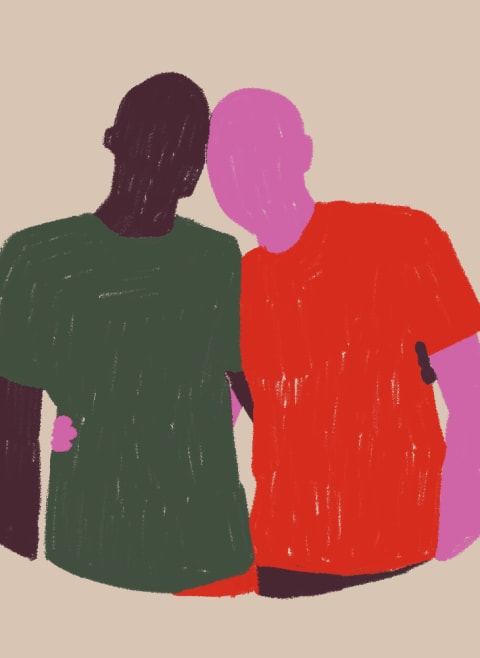Side Hug Body Language
Are you curious about the side hug body language? Well, you’re in the right place! Side hugs are a popular way to express friendship, affection, or greeting someone.
Imagine this scenario: You’re walking down the hallway, and your friend approaches you with a big smile. Instead of a traditional full-on hug, they give you a cozy side hug, their arm wrapped around your shoulder.
Side hugs have their own unique meaning and can say a lot about your relationship with someone. So, let’s delve into the fascinating world of side hug body language and uncover its hidden messages!
But why are side hugs so popular? What do they signify? Stay tuned as we explore the different interpretations and nuances behind this type of embrace. You’ll discover interesting insights about human interaction and the unspoken language of physical touch. So, let’s dive right in and learn more about the captivating world of side hug body language!
Discover the hidden messages behind a side hug! While it may seem like a casual gesture, this form of body language can reveal a lot about our relationships. The way someone positions their body, the duration of the hug, and the level of closeness can all convey different meanings. Learn to interpret the unspoken signals by observing these key factors. Understanding side hug body language can enhance your social interactions and deepen your connections.

Decoding Side Hug Body Language: What Does It Say About Your Relationship?
Side hugs are a common and often overlooked form of body language that can reveal a lot about the dynamics of a relationship. Unlike the more intimate front-facing hug, a side hug is typically less intimate and often used in platonic relationships or casual greetings. Despite its seemingly innocent nature, the way someone engages in a side hug can convey subtle messages and offer insights into their feelings. In this article, we will explore the meaning behind side hug body language and how to interpret it in various contexts.
The Tight Side Hug: A Sign of Deep Connection
When someone pulls you close in a tight side hug, wrapping their arm firmly around your waist, it often signifies a close bond and a sense of trust. This type of side hug is commonly shared between close friends, family members, or romantic partners. The tight grip and prolonged contact suggest a desire for physical and emotional closeness. It communicates a sense of comfort, protection, and a willingness to provide support. It’s important to note that this form of side hug is typically reserved for individuals with strong existing relationships or a level of emotional intimacy.
On the other hand, a tight side hug can also indicate possessiveness or a desire to establish dominance within a relationship. If the person initiating the hug consistently uses excessive force or insists on being the one to control the embrace, it may be a red flag for potential boundary issues. It’s crucial to assess the overall context of the relationship and the consistency of such behavior to determine whether it stems from a genuine deep connection or if it’s a sign of control.
The Loose Side Hug: Maintaining Boundaries and Casual Connection
A loose side hug, characterized by a relaxed arm around the shoulder or waist, signifies a more casual connection between individuals. This type of hug is common among acquaintances, classmates, or colleagues. It demonstrates a sense of familiarity and friendliness without crossing the boundaries of a more intimate embrace. The loose side hug is typically accompanied by a quick release and a step back, indicating a desire to maintain personal space.
In some cases, a loose side hug may be used as a polite gesture when someone doesn’t feel comfortable with physical contact or wants to keep the relationship at a distance. If you find yourself consistently receiving only loose side hugs from someone you consider close, it might be worth examining the level of emotional closeness and communication within the relationship. It could be an indication that the other person is trying to keep a certain level of emotional distance or is uncomfortable with deeper connections.
One-Sided Side Hug: Power Dynamics and Unbalanced Relationships
The one-sided side hug, where one person initiates the hug while the other remains passive or unwilling to reciprocate, can reveal imbalances or power dynamics within a relationship. If someone consistently engages in one-sided side hugs or avoids physical contact altogether, it might imply that they are not fully engaged or invested in the relationship. This could be a sign of hidden resentment, a lack of trust, or dissatisfaction.
To establish healthier dynamics in relationships where one-sided side hugs occur, open and honest communication is key. By addressing any underlying issues, both individuals can work towards understanding and compromise. It’s important to note that there may be various reasons for one-sided side hugs, and it’s essential to consider the overall context and non-verbal cues before drawing conclusions.
Signs of Discomfort: Recognizing Non-Verbal Cues
Understanding side hug body language goes beyond just the positioning of the arms; it also requires paying attention to other non-verbal cues. Signs of discomfort during a side hug may include a tense body posture, a lack of reciprocal arm positioning, minimal or no eye contact, and a desire to break free from the embrace quickly. These cues can suggest uneasiness, aversion, or a lack of enthusiasm towards the hugger or the relationship itself.
If you notice signs of discomfort during side hugs, it’s crucial to respect the other person’s boundaries and comfort levels. Everyone has different preferences when it comes to physical contact, and forcing a hug on someone who doesn’t want it can be invasive and disrespectful. Always ask for consent and be mindful of verbal and non-verbal cues before initiating or reciprocating physical contact.
Interpreting Side Hug Body Language in different Contexts
Side hug body language can vary depending on the cultural context, personal preferences, and the individuals involved. It’s important to consider these factors before drawing any conclusions. For example, in certain cultures, side hugs may be the preferred form of greeting, regardless of the level of intimacy. Additionally, someone may have personal reasons or trauma history that affects their comfort level with side hugs.
When interpreting side hug body language, it’s essential to consider the broader context of the relationship, including verbal communication, history, and individual personalities. Body language should be taken as a supplementary tool for understanding, rather than the sole basis for judgment or assumptions. The key is to be attentive, empathetic, and respectful of each person’s unique boundaries and comfort levels.
Mastering the Art of Side Hugs: Dos and Don’ts
To ensure respectful and positive interactions when engaging in side hugs, follow these simple guidelines:
Dos:
1. Respect personal boundaries and only initiate a side hug if the other person is open to physical contact.
2. Pay attention to the other person’s non-verbal cues and adjust your level of intimacy accordingly.
3. Ask for consent before initiating physical contact, especially with individuals you’re less familiar with.
4. Maintain an open and relaxed body posture during side hugs to create a comfortable and welcoming environment.
5. Practice empathy and respect by being aware of cultural differences and individual preferences when it comes to physical contact.
Don’ts:
1. Force a side hug on someone who is reluctant or uncomfortable with physical contact.
2. Assume that a side hug indicates a deep emotional connection; other factors should be considered.
3. Overanalyze or jump to conclusions based solely on side hug body language. Remember that it’s just one element of communication.
4. Disregard personal space boundaries by holding the other person for longer than they seem comfortable with.
5. Use side hugs as a way to control or assert power within a relationship. Respect and equality should always be maintained.
Unlocking the Subtle Messages: Understanding Side Hugs in Different Relationships
Throughout our lives, we engage in interactions with various people, from acquaintances to romantic partners. Each relationship brings its unique dynamics and intricacies, and side hugs can offer valuable insights into these connections. Whether it’s a tight side hug that signifies deep emotional bonds or a loose and casual embrace between friends, understanding the nuances of side hug body language can enhance our understanding of relationships and foster healthier connections. In the following sections, we will explore side hug body language in different relationship scenarios and discuss its underlying meanings.
Side Hugs Among Friends: The Power of Platonic Affection
Friendships are often marked by affectionate gestures, and side hugs are no exception. When friends engage in side hugs, it can signify a sense of camaraderie, trust, and emotional support. The level of intimacy and physical contact in side hugs between friends may vary depending on cultural factors and individual preferences, but the underlying message remains the same: a demonstration of care and friendship.
In platonic relationships, side hugs are often exchanged as a form of greeting or goodbye, particularly among friends who have known each other for a long time. It’s a way to acknowledge and celebrate the bond while maintaining boundaries. These casual side hugs are usually loose in nature, allowing both parties to maintain personal space while still expressing affection and warmth.
Side Hugs in Romantic Relationships: A Blend of Intimacy and Comfort
In romantic relationships, side hugs can take on a deeper level of meaning. They provide an opportunity for physical closeness while still respecting personal boundaries. The intensity and duration of side hugs between romantic partners often reflect the level of emotional connection and the comfort they share.
A tight side hug in a romantic relationship signifies not only physical intimacy but also emotional support, protection, and a sense of belonging. It communicates a deep level of trust and affection between partners. These hugs may be accompanied by whispered words of love, gentle caresses, or a lingering embrace, further solidifying the bond between them.
Conversely, a loose side hug in a romantic relationship may indicate a desire to maintain a sense of independence and personal space while still expressing affection. It can be a way for partners to strike a balance between physical connectedness and individuality within the relationship.
Side Hugs in Professional Settings: Striking the Right Balance
In professional settings, side hugs are typically less common and often replaced by firm handshakes or polite nods. However, depending on the workplace culture and individual relationships, side hugs may occur, albeit in a more restrained and cautious manner. It’s essential to navigate these situations with professionalism and respect for personal boundaries.
In professional settings, side hugs should be approached with caution, ensuring that they are consensual and appropriate. A loose and quick side hug, accompanied by a friendly smile, may be acceptable among colleagues who have known each other for an extended period. However, it’s crucial to consider the individual’s comfort level, cultural appropriateness, and professional etiquette before initiating or reciprocating a side hug.
The Power of Non-Verbal Communication: Interpretation and Awareness
Non-verbal communication, including side hug body language, plays a significant role in our interactions with others. By paying attention to these subtle cues, we can gain insights into the dynamics of relationships and better understand the unspoken messages being conveyed. It’s essential to approach the interpretation of side hug body language with sensitivity and open-mindedness, considering individual preferences, cultural differences, and the broader context of the relationship. When in doubt, respectful communication is key to ensure that both parties feel comfortable and respected. So, the next time you find yourself engaging in a side hug, take a moment to consider the underlying meanings and appreciate the power of non-verbal communication.
Key Takeaways: Side Hug Body Language
- A side hug can indicate a friendly and casual relationship.
- It is often used between friends or acquaintances.
- A side hug typically involves one arm around the other person’s shoulder or waist.
- It is important to read the other person’s body language and cues to determine if they are comfortable with a side hug.
- Always be mindful of personal boundaries and respect the other person’s comfort level.
Frequently Asked Questions
When it comes to body language, side hugs can say a lot. Here are some commonly asked questions about side hug body language, answered in detail.
1. What does it mean when someone gives you a side hug?
When someone gives you a side hug, it generally signifies a friendly and familiar relationship. Side hugs are often seen among friends or acquaintances, where the level of intimacy may not be as deep as with a full-frontal hug. This type of hug typically indicates a sense of closeness, trust, and camaraderie. It can also convey a platonic connection rather than a romantic one.
However, it’s important to consider cultural and personal differences, as the meaning of a side hug may vary from person to person. Some individuals may simply feel more comfortable giving side hugs, while others may use this type of hug as a way to maintain personal boundaries.
2. What are some situations where side hugs are appropriate?
Side hugs are often appropriate in casual or informal settings. They can be seen among friends catching up, colleagues celebrating a milestone, or teammates displaying camaraderie. Side hugs are also commonly used when greeting someone you know but may not be particularly close with, such as an acquaintance or a friend of a friend.
However, it’s crucial to be aware of individual preferences and cultural norms. Some people may feel uncomfortable with any form of physical contact, while others may prefer different types of hugs. It’s always a good idea to gauge the other person’s comfort level and respect their boundaries.
3. Can a side hug be romantic?
While side hugs are generally associated with platonic relationships, they can carry a romantic undertone depending on the context and individuals involved. In certain situations, a side hug can be a subtle way of expressing affection or signaling romance without being too forward. However, it’s important to remember that everyone has their own interpretation of and comfort with physical touch, so it’s essential to communicate and seek consent.
If you want to express romantic interest or deepen a romantic relationship, it may be more appropriate to use different forms of physical affection, such as a front hug or an embrace that lasts longer than a side hug.
4. How do you give a proper side hug?
To give a proper side hug, it’s important to be mindful of the other person’s comfort and personal space. Start by approaching the person from the side, facing the same direction. Extend your arm around their shoulders or waist and gently pull them towards you, making sure to avoid applying too much pressure or invading their personal space.
Keep the hug brief and light, and be aware of any cues or signs that the other person may not be comfortable with physical contact. Always respect the other person’s boundaries and be mindful of cultural and personal differences. The goal is to make the other person feel comfortable and secure, so adjusting your approach based on their comfort level is key.
5. Are there any cultural differences in the interpretation of side hugs?
Yes, cultural differences can greatly influence the interpretation of side hugs. In some cultures, physical touch and embracing are more common and encouraged, while in others, personal space is highly valued, and any form of physical contact may be reserved for close family or romantic partners. It’s important to be aware of and respectful towards these cultural norms when interacting with individuals from different backgrounds.
Additionally, personal preferences regarding physical touch and side hugs may vary widely. Some individuals may enjoy side hugs and feel comfortable with them, while others may have personal boundaries that should be respected. When in doubt, it’s always best to ask or observe the behavior of others in a particular cultural or social setting.

11 Types Of Hugs And What They Really Mean
Summary
In this article, we learned about side hug body language. A side hug is when people hug each other with their sides touching, rather than facing each other directly. Side hugs are often casual and friendly gestures between friends or acquaintances. They can show that you care about someone and want to show affection, but you’re not overly intimate. It’s important to remember that different cultures and individuals may have different preferences when it comes to hugging. So it’s always a good idea to be aware of people’s comfort levels and boundaries when offering a side hug.
